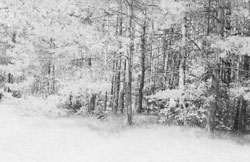
Ariel Yannay-Shani, Auschwitz, Treblinka, 2006, silver print
On April 29, 2008, one hundred students and guests gathered at theCamera Obscura School of Art in Tel Aviv for a seminar on the visual representation of the Holocaust. The seminar was held in commemoration of Holocaust Remembrance Day 2008, and was jointly sponsored by Yad Vashem’s Visual Center and Camera Obscura.
“The idea for a seminar was the result of a recent guided tour of Yad Vashem for Camera Obscura faculty and students that highlighted the films and other media productions in the permanent exhibit of the Holocaust History Museum,” explained Dorit Leor, Academic Director of Camera Obscura. “We found a common language with the Visual Center’s staff, and decided to collaborate with them to offer our students an opportunity to examine issues of remembrance and visual representation.”
Keynote speaker Dr. Robert Rozett, Yad Vashem Libraries Director, surveyed depictions of the Holocaust in literature and scholarly research. Visual Center Director Liat Benhabib outlined the development of Holocaust-related cinema, especially in its third generation, affirming “…the importance of a dialogue between film students and the Visual Center in order to promote an understanding of Holocaust-related cinema, as well as the production of quality films on the subject.” A screening of a recently restored, Hebrew-subtitled copy ofNight and Fog (Alain Resnais, 1955) followed Benhabib’s lecture.
Film director and Camera Obscura lecturer Serge Ankri addressed the tradition of Holocaust representation in French cinema, especially in the films of Alain Resnais, Marcel Ophuls and Claude Lanzmann. Mimi Ash, Visual Center Coordinator of Acquisitions & Special Projects, discussed Lanzmann’s aesthetic and moral choices in Shoah (1985).
Contemporary visual representations of the Holocaust were also reviewed. Neomi Schory, Director of the Film Department at Beit Berl College, explained the relationship between ideas and their implementation in the films in the permanent exhibit of the Holocaust History Museum at Yad Vashem, focusing on their potential impact on historical memory. Current examples of Holocaust-related still photographs and video art were given by Ariel Yannay-Shani, Director of the Photography Department at Camera Obscura, and by Camera Obscuragraduate and artist Eliassaf Kovner. “The seminar made me much more aware of the challenges involved in conveying the memory of the Holocaust,” said Kovner.
Just before the seminar’s conclusion, Dutch-born author and Holocaust survivor Betty Bausch made an urgent appeal to the young art students: “As young people, you have a special role...you may meet Holocaust survivors who don’t want to talk about their experiences, but you must urge them to speak up, while they still can. The silence must be broken.”
The author is the Coordinator of Acquisitions & Special Projects at Yad Vashem’s Visual Center










